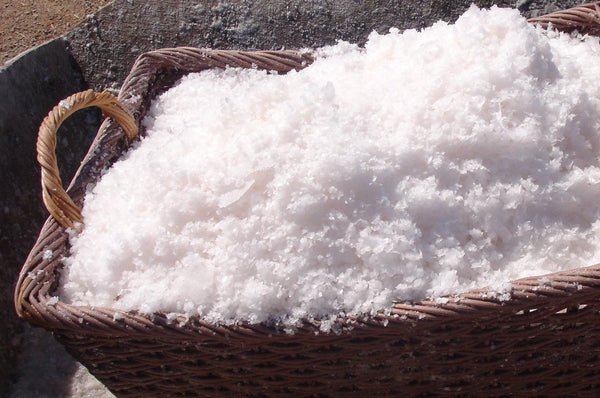
We’ve all heard the generalized notion that salt is bad. We’ve been told to watch our sodium intake to avoid compromising our health. But if sodium is a necessary natural mineral, playing a vital role in a number of our body functions, how can it be all that bad? If it is an essential nutrient, how can we be sure we’re providing our bodies with the right kind of salt? And in the right amount?
Let’s take a look at the different types of salt, granule by granule, from worst to best:
Table Salt:
The most commonly used salt–and the one that gives all salt a bad name–is table salt, highly refined and processed into almost pure sodium chloride. Somehow, we’ve bought into the myth that the addition of iodine makes table salt safer. Iodine was first added to salt in the 1920s as part of a government initiative adopted to combat iodine deficiency stemming from a lack of mineral rich soil and iodine enriched foods available for consumption.
“Commonly purchased iodized salts, available at super markets or sitting on the table of your favorite restaurant, have synthetic chemicals added to them. These chemicals include everything from manufactured forms of sodium solo-co-aluminate, iodide, sodium bicarbonate, fluoride, anti-caking agents, toxic amounts of potassium iodide and aluminium derivatives. It may come as a shock, but most table salt is not only unhealthy, but can sometimes be toxic.” (Dr. Edward Group DC, NP, DACBN, DCBCN, DABFM)
Kosher Salt:
Though coarse and flaky, make no mistake, Kosher salt is not sea salt. While it has slightly fewer additives than table salt, it’s essentially the same, just bigger. The size of the granule is one of the biggest reasons why chefs use kosher salt—it’s much easier to pick up between your fingers, allowing chefs tighter control over seasoning. Go ahead and substitute table salt for Kosher salt, but if you do, be sure to use half as much due to the size of the grain.
Sea Salt:
Evaporated ocean water goes through minimal processing to produce sea salt. Sea salt is purer than table salt or Kosher salt, but generic sea salt on store shelves isn’t the healthiest pick. Why? Because it is still primarily sodium chloride. While it contains a few trace minerals, sea salt also may have traces of heavy metals absorbed from pollutants in the ocean–not exactly a health benefit.
Himalayan Pink Salt:
Now we’re in the pink. Himalayan salt crystals (whether pink or another color) are considered “diamonds of the sea,” found in the Punjab region of Pakistan. Because the salt crystals have remained imbedded in the mountainsides of receded ancient sea beds, Himalayan pink salt is a very dry salt. Though filled with enriched minerals, many have been leeched due to exposure to natural elements. Still, Himalayan sea salt contains 84 different minerals and elements, more than any other unrefined sea salt. Between its distinct flavor and noted health benefits (such as improving hydration and balancing blood sugar), it is the safer “go-to” in the category of culinary sodium seasonings.
Sel Gris/Celtic Salt:
Nothing compares to the moist, complex yet delicate flavor of the rarest salt in the world, “sel gris,” or “Celtic salt.” Hand harvested from the medieval oceanside village of Guérande in Brittany, France, sel gris is completely additive free and organic. Unlike dry Himalayan salt rocks, moist sel gris is actively mined from the Atlantic Ocean. Not only does sel gris offer nearly 100 nutrients and trace minerals, it also has the lowest sodium content of any salt, meeting the standards of one the most rigorous salt certification in the world, France’s Nature et Progrès. And while Himalayan pink salt has a mineral content of 2.5% – 3.0%, Sel Gris boasts between 13% – 17% minerals.
Sel de Guérande is 100% natural, unwashed and without additives, which explains why it is widely coveted by gourmet enthusiasts and highly regarded by health experts. It’s also the reason Salinity Salts takes such pride in sourcing sel gris straight from the sauniers (salt harvesters) of the Salinity Ponds in Guérande. It is the beginning of the purest ingredients used in blending each of our finishing salt infusions. Check out our growing selection of delicious, healthy, gourmet finishing salts.
Yes cooking Rib-eye ot T-bones with Sea salt is the way to go
Comments will be approved before showing up.

Discover 5 essential ingredients and flavors we discovered on a recent trip to Cabo San Lucas, Mexico. From smoky cocktails to indulgent sweet treats, you'll find a range of inspiration for every time of day here!

We’re definitely in the heat of summer and that means firing up the grill! If you are looking for some tools to show off your chops (as well as cook them) we found Arctic Monsoon to be a great resource. Whether you are a seasoned grill master or a beginner you’ll want to check out Artic Monsoon’s interview of the number one expert on grilling: his dad.
7 Tips For Grilling Success focuses on questions for the "beginner" but it offers a good review of the basic grilling tips that will make you rock star on the weekends!

More than 6,000 moms took an un-scientific survey on TODAY.com to reveal what moms REALLY want for Mother’s Day. Nearly 70 percent agree they'd prefer two extra hours of sleep over a piece of expensive jewelry.
Laurel Coppock, one of the comedic moms behind YouTube channel The Breakwomb, agrees.
“I would always like two extra hours of sleep,” said Coppock. “Fancy massage? No. Two extra hours of sleep, please. Gift from my husband? Yes, please, as long as it’s two extra hours of sleep. I would also love breakfast in bed, provided that I can sleep through it.”
lester
February 24, 2019
Where is my commit